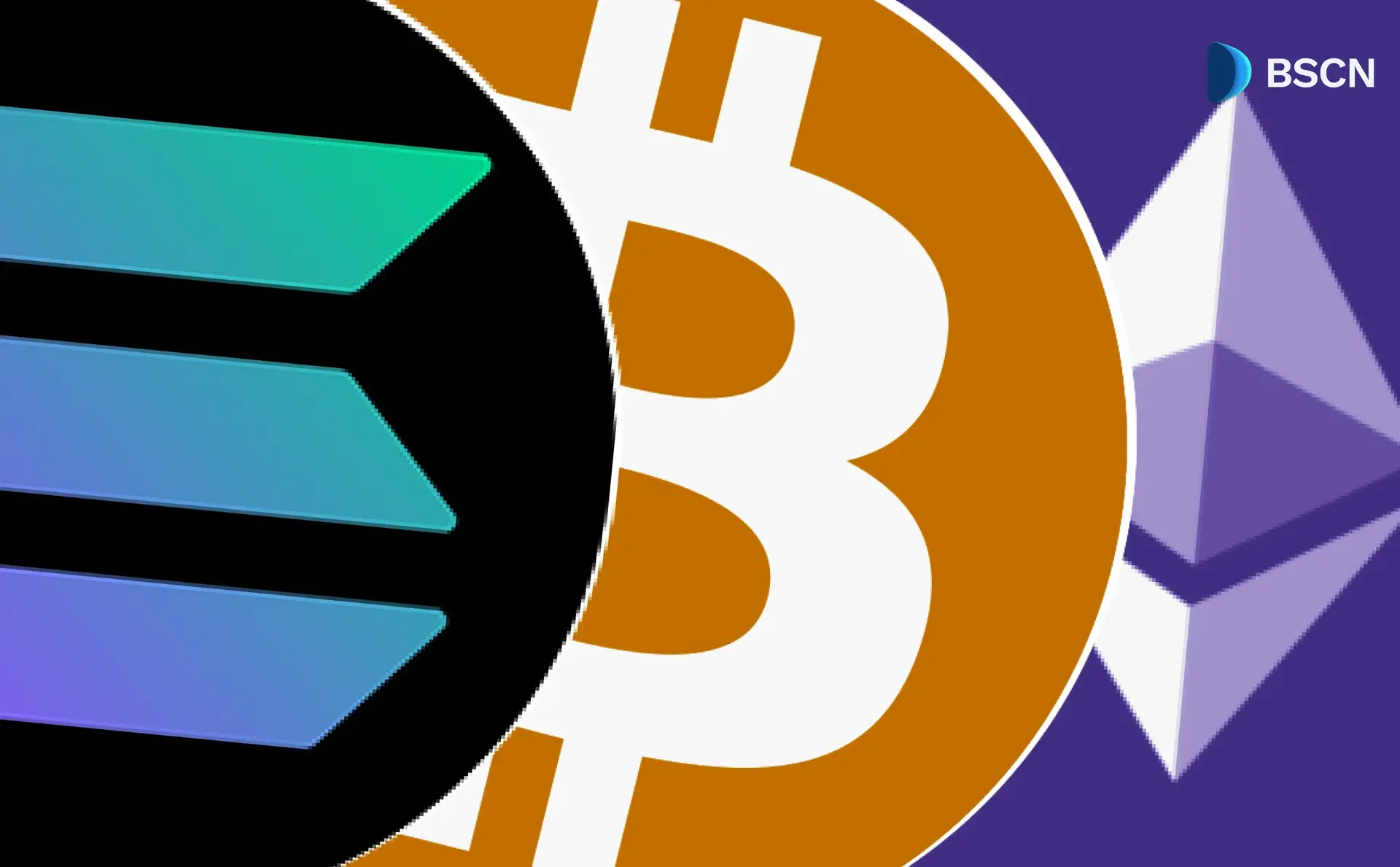News
(Advertisement)
Chainlink Powers Bitlayer YBTC to Expand Bitcoin DeFi

Bitlayer adopts Chainlink CCIP to power YBTC, enabling secure cross-chain Bitcoin DeFi with trust-minimized interoperability between Ethereum and Bitcoin Layer 2.
Soumen Datta
September 12, 2025
(Advertisement)
Table of Contents
Bitlayer, a Bitcoin Layer 2 network, has adopted Chainlink’s Cross-Chain Interoperability Protocol (CCIP) to power YBTC, its Bitcoin-pegged token. The move establishes CCIP as Bitlayer’s canonical cross-chain infrastructure, securing asset transfers between Bitlayer and Ethereum.
Leading Bitcoin layer 2 @BitlayerLabs has successfully migrated to Chainlink CCIP as its canonical cross-chain infrastructure.
— Chainlink (@chainlink) September 12, 2025
The Chainlink interoperability standard now powers secure transfers between Bitlayer and Ethereum for Bitlayer’s native token BTR, USDC, USDT, ETH, and… pic.twitter.com/NDIhizbAKo
With this integration, Bitlayer expands its Bitcoin decentralized finance (DeFi) (BTCFi) ecosystem by enabling secure movement of tokens such as BTR, USDC, USDT, ETH, and wstETH, while making YBTC trust-minimized and multichain through Chainlink’s infrastructure.
“By harnessing CCIP’s native support for secure cross-chain asset transfers and messages, Bitlayer developers can now unlock a new wave of BTCFi innovation,” Johann Eid, Chief Business Officer at Chainlink Labs, said.
Earlier this year, Bitlayer has raised nearly $30 million from investors including Polychain Capital, Franklin Templeton, and Framework Ventures.
Bitlayer and Its Bitcoin Layer 2 Approach
Bitlayer was co-founded by Kevin He and Charlie Hu in October 2023 as a Bitcoin Layer 2 designed to overcome Bitcoin’s limitations in scalability and programmability. By using the BitVM paradigm, Bitlayer enables Turing-complete Bitcoin contracts through an optimistic validation scheme.
This design allows developers to deploy EVM-compatible applications while preserving Bitcoin’s security guarantees. The introduction of YBTC is central to this strategy, offering a native Bitcoin representation that can be used across multiple blockchains.
What YBTC Brings to the Table
YBTC is Bitlayer’s Bitcoin-pegged asset designed to unlock yield-bearing opportunities while maintaining trust-minimization. Unlike traditional wrapped BTC models that rely on custodians, YBTC leverages BitVM and Chainlink CCIP for a more decentralized approach.
Key Features of YBTC
- Bitcoin-pegged representation: Maintains direct value parity with BTC.
- Multichain functionality: Accessible across Ethereum, BSC, Avalanche, Plume, and more via CCIP.
- Trust-minimized minting: Uses BitVM-based bridges rather than centralized custodians.
- Yield opportunities: Supports integration into DeFi protocols for lending, trading, and derivatives.
Currently, YBTC.B (Bitlayer’s first version) is live across several EVM-compatible blockchains. With CCIP, YBTC will expand further, connecting liquidity pools across networks.
Chainlink CCIP as the Canonical Infrastructure
Chainlink CCIP is a decentralized protocol enabling secure and verifiable cross-chain communication. It allows tokens, messages, and data to move across blockchains without relying on traditional custodial bridges.
According to Bitlayer, it selected CCIP for several reasons:
- Security: CCIP’s consensus is powered by Chainlink Decentralized Oracle Networks (DONs), infrastructure that has secured over $90 billion in DeFi TVL at peak.
- Reliability: Built on Chainlink’s proven infrastructure, which has enabled over $25 trillion in onchain transaction value.
- Future-proof design: Allows onboarding of additional blockchains and tokens without rewriting contracts.
- Always-on availability: No downtime in transfers, ensuring consistent cross-chain functionality.
By adopting CCIP, Bitlayer gains access to secure asset transfer solutions while enabling developers to build cross-chain applications without custom bridge designs.
How the Integration Works
The integration covers multiple layers of asset interoperability between Ethereum and Bitlayer.
Supported Assets at Launch
- Bitlayer’s native token (BTR)
- USDC
- USDT
- ETH
- wstETH
The next step in Bitlayer’s roadmap is making YBTC fully cross-chain native via CCIP. This will transform YBTC into a yield-bearing, multichain Bitcoin asset accessible across multiple ecosystems.
“With the successful migration of key assets to CCIP as our canonical cross-chain infrastructure, developers can build novel BTCFi apps on Bitlayer and drive ecosystem growth,” Kevin He, Co-founder of Bitlayer, added.
Expanding BTCFi Through Interoperability
Bitcoin DeFi, often called BTCFi, refers to decentralized finance applications powered by Bitcoin as collateral. Bitlayer’s adoption of CCIP enables this ecosystem to scale.
Developers and users benefit from:
- Increased liquidity: Seamless bridging of Bitcoin-pegged assets into Ethereum and other chains.
- Secure applications: Developers can build trust-minimized BTCFi apps without relying on centralized custodians.
- Scalable ecosystem: Interoperable BTCFi across lending, trading, and derivatives.
Users can access CCIP-powered transfers through Transporter, XSwap, and Interport, simplifying the process of moving assets securely.
Chainlink Expands Cross-Chain Reach
The Bitlayer-Chainlink partnership follows several recent developments that highlight Chainlink’s growing role in interoperability:
- Sei Network Integration: Chainlink Data Streams went live, bringing real-time data for equities, GDP, and over 300 assets.
- Aptos Deployment: Chainlink CCIP launched on Aptos mainnet, connecting it to 60+ EVM and non-EVM blockchains.
- Shiba Inu (SHIB) Cross-Chain Lending: SHIB became the first memecoin listed on cross-chain lending markets via Folks Finance and CCIP.
Conclusion
Bitlayer’s adoption of Chainlink CCIP establishes a secure and standardized framework for cross-chain Bitcoin DeFi. By making YBTC trust-minimized and multichain, Bitlayer improves liquidity, reduces reliance on custodians, and expands BTCFi applications across networks.
With support for major assets and upcoming YBTC deployment, this partnership emphasizes how interoperability standards like CCIP are shaping the future of decentralized finance infrastructure.
Resources:
Bitlayer announcement about migrating to Chainlink CCIP as Its canonical cross-chain infrastructure to power YBTC: https://blog.bitlayer.org/bitlayer_successfully_migrates_to_Chainlink_CCIP/
Bitlayer docs: https://docs.bitlayer.org/docs/Learn/Introduction
Sei Network announcement about Chainlink Data Streams integration: https://blog.sei.io/chainlink-data-streams-now-live-on-sei/
Chainlink CCIP Goes Live on Aptos - Press release by Chainlink and Aptos: https://www.prnewswire.com/news-releases/chainlink-ccip-goes-live-on-aptos-unlocking-defi-liquidity-and-advancing-institutional-adoption-with-aave-302549847.html
Read Next...
Frequently Asked Questions
What is YBTC on Bitlayer?
YBTC is a Bitcoin-pegged asset on Bitlayer, designed to provide a trust-minimized and yield-bearing representation of BTC across multiple blockchains.
How does Chainlink CCIP improve interoperability for Bitlayer?
Chainlink CCIP allows secure, verifiable, and transparent transfers of assets between Bitlayer and Ethereum, enabling scalable BTCFi applications.
Which assets are supported on Bitlayer through CCIP?
Currently, CCIP supports transfers of BTR, USDC, USDT, ETH, and wstETH. YBTC will soon be fully cross-chain native.
Disclaimer
Disclaimer: The views expressed in this article do not necessarily represent the views of BSCN. The information provided in this article is for educational and entertainment purposes only and should not be construed as investment advice, or advice of any kind. BSCN assumes no responsibility for any investment decisions made based on the information provided in this article. If you believe that the article should be amended, please reach out to the BSCN team by emailing [email protected].
Author
 Soumen Datta
Soumen DattaSoumen has been a crypto researcher since 2020 and holds a master’s in Physics. His writing and research has been published by publications such as CryptoSlate and DailyCoin, as well as BSCN. His areas of focus include Bitcoin, DeFi, and high-potential altcoins like Ethereum, Solana, XRP, and Chainlink. He combines analytical depth with journalistic clarity to deliver insights for both newcomers and seasoned crypto readers.
(Advertisement)
Latest News
(Advertisement)
Crypto Project & Token Reviews
Project & Token Reviews
Comprehensive reviews of crypto's most interesting projects and assets
Learn about the hottest projects & tokens
Latest Crypto News
Get up to date with the latest crypto news stories and events













